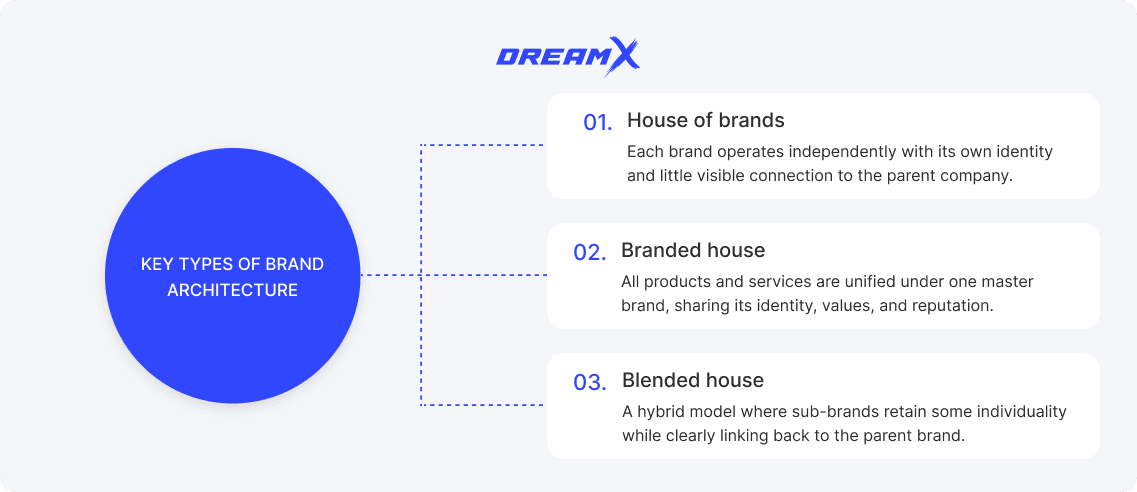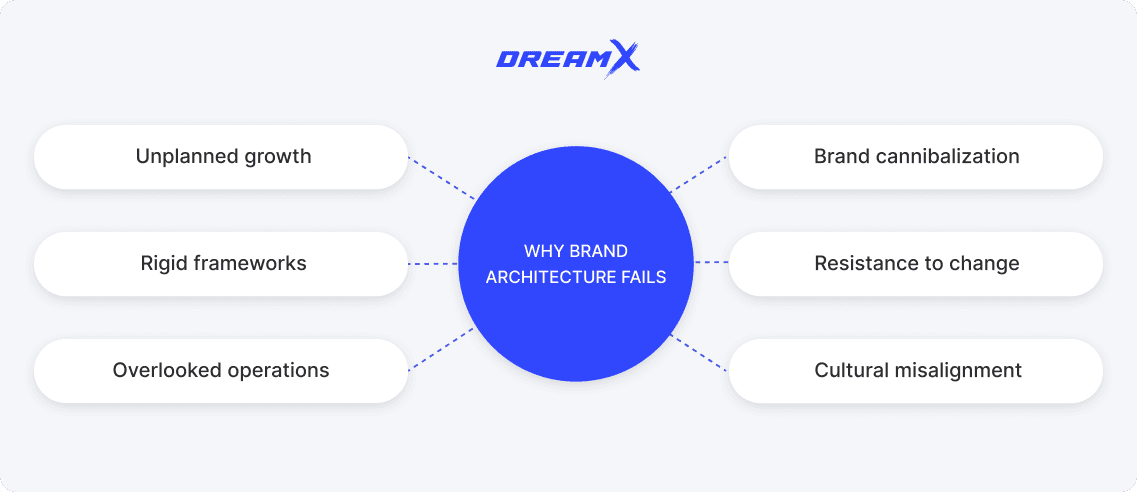Pretty often, a business is not limited to a single brand. It can be a corporation leading several brands, each of which is tailored to a particular audience and market demand. Many businesses become parent companies by owning an array of smaller companies and brands. While founding a house of brands brings many financial rewards and substantial growth results, it still requires a clear structure designating the interrelations between brands within a business. This structure helps to solidify corporate hierarchy and set relevant priorities and boundaries. But how to achieve it? This point is where brand architecture comes into play.
As an aspiring startup or small business owner, you may wonder, “What is brand architecture?” Well, it is actually the framework an organization usually relies on to depict and supervise interrelationships between the parent company and its sub-brands. Brand architecture serves as the structure of a company that enables a business owner to explain the connections between a business’s master brand and sub-brands, emphasizing service and product lines. Having it at hand helps in brand portfolio management and brand positioning. A defined brand hierarchy can help you articulate the value your brands bring to target customers more effectively. Consequently, brand architecture becomes an inevitable part of the overall and independent brand management, ensuring efficient positioning in diverse markets. Additionally, you can give your customers and potential clients a clear picture of your brand universe with a well-shaped brand architecture.
The overarching purpose of a brand architecture is to arrange a company’s brand portfolio (that is, all the brands that work under a larger corporate umbrella), services, and products in a way that sheds light on their relationships to clients while satisfying evolving customer expectations and maximizing business value. With the right brand architecture strategy, you can control how people perceive your brand. A clear structure allows customers to grasp the connections between brands and offerings within your company, making it easier for people to trust your business. This way, consumers make confident purchasing decisions and come back for more.
Coherent brand architecture looks like a game-changer for large businesses. So, let’s go deeper and explore the intricacies of brand architecture, its role in corporate branding, its types, and future trends.
Why brand architecture matters
Once you grasp the brand architecture meaning, it is time to go through the importance of having one. Actually, well-implemented architecture can do wonders for a business. It nourishes companies with strategic brand alliances and parent brand support, and even more. Here are the reasons companies should care about brand architecture.
Bigger profits
When a corporation has a clear brand architecture, it can reach higher financial goals. Businesses can increase revenue by incorporating cross-selling. A well-defined structure of the brands within the larger company and its master brand approach allows sub-brands to feed off each other with value propositions and attractive goods tailored to vast audiences. Profits grow according to the success rates of interrelated brands operating under the organization. If a single brand related to the parent company delivers a positive user experience, then other related partners within the brand portfolio get more opportunities for growth.
Brands related to a specific niche and target audience will positively promote the parent brand and eventually drive sales and growth. This way, the parent company gets more opportunities to expand its customer base and generate new revenue.
Smooth change management
When facing external influences, businesses should change over time and adapt. These influences can prompt companies to resort to changes like introducing new goods, a polished brand strategy, or a marketing approach like mixed branding. Despite the obstacles a company encounters, a strong brand architecture can help in managing the change process.
Better brand image
By exploiting branding architecture, you can reduce overall damage to your brand and even improve its image. It helps create a trustworthy reputation among partners and clients who clearly understand how your company operates. A well-compiled brand architecture enhances clarity, marketing efforts, and positive perception.
Key types of brand architecture
Brand architecture types refer to an approach that arranges brands under the leading, overarching brand. These leading companies are usually called master, parent, family, umbrella, or corporate brands. A parent brand manages several brands that produce different products and service offerings to a wide audience. The sub-brands provide diverse goods and experiences at various prices.
Here, you will find three main brand architecture models featuring master/parent brands with sub-brands.

House of brands
The house of brands structure maintains distinct, standalone brands with minimal visible connection to the parent company. Each brand operates independently with its own identity, positioning, and target audience. Companies like Procter & Gamble employ this strategy, allowing brands like Tide, Pampers, and Gillette to thrive in their respective categories without consumer awareness of their common ownership.
The branded house
This architecture leverages a single master brand across all products and services. Each offering directly reflects the parent brand's identity, values, and promise. Companies like Apple exemplify this approach, with products like iPhone, MacBook, and Apple Watch clearly unified under the Apple brand, creating consistency and transferring brand equity across the entire portfolio.
The blended house
This hybrid approach combines elements of both architectures, featuring a prominent master brand with distinct sub-brands. Sub-brands maintain some individual identity while benefiting from the parent brand's reputation. FedEx demonstrates this with offerings like FedEx Express and FedEx Ground, where each service has its own positioning while remaining clearly connected to the master brand.
Choosing the right brand architecture strategy
Nobody doubts that branding is vital for startups. However, the structure is paramount, too. Selecting the optimal brand architecture requires balancing multiple business considerations against market realities. Begin by evaluating your current portfolio's strengths, target audiences, and competitive positioning. Consider your long-term business strategy—whether focused on acquiring diverse brands or building a unified experience. Assess how much brand equity transfers between offerings and whether customer segments overlap or remain distinct. Weigh operational efficiencies against market differentiation needs. The ideal architecture evolves with your business, allowing flexibility while maintaining strategic clarity. Rather than rigidly applying textbook models, successful companies often develop custom architectures that reflect their unique market position, customer relationships, and growth trajectories, adapting frameworks to fit their specific business context.
Common challenges and pitfalls
While businesses should cover the brand development cost, they also have to invest in a decent brand architecture. Many organizations struggle with brand architecture that evolves haphazardly through acquisitions or product launches without strategic oversight. This creates customer confusion, internal inefficiencies, and diluted brand equity.
Another common pitfall is forcing rigid theoretical models onto complex business realities rather than adapting frameworks to specific needs. Companies frequently underestimate the operational implications of their chosen architecture, particularly regarding resource allocation and decision-making autonomy. Brand cannibalization often emerges when portfolio boundaries blur.
Additionally, organizations may resist necessary architecture evolution as markets change, clinging to outdated structures that no longer serve business objectives. International expansion particularly tests architecture resilience, as cultural differences may require regional adaptations to maintain effectiveness.
Future trends in brand architecture
Brand architecture is evolving rapidly in response to digital transformation and changing consumer behaviors. Increasingly, companies are adopting dynamic, flexible frameworks that allow rapid pivoting as market conditions shift. We're seeing the rise of purpose-driven architectures where values and social commitments become organizing principles across portfolios. Digital-native companies often employ network-based architectures that emphasize ecosystem connectivity rather than traditional hierarchies. Brand collaborations and strategic partnerships are creating temporary architectural connections that expand reach without permanent portfolio changes. Personalization is also driving more adaptive architectures where individual customer experiences redefine brand relationships.
Finally, as direct-to-consumer models proliferate, many organizations are simplifying their architectures to create more transparent, accessible brand relationships with empowered consumers.
Conclusion
To sum up, brand architecture is a crucial foundation that defines how organizations leverage and manage their brand portfolios. As businesses evolve, it is critical to shape a clear structure within them. A well-designed brand architecture provides a sustainable competitive advantage, creates clarity for partners and customers, and ensures operational efficiency for the business. So, go for a balanced architecture for your business and adapt to emerging opportunities!






